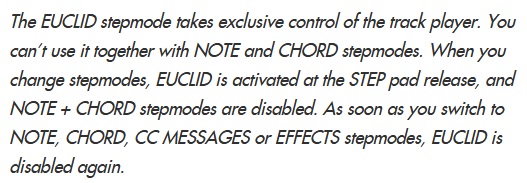Hi everyone,
I’m trying to layer euclidean patterns in a track to generate various drum ostinatos. Here’s my current workflow that’s not working correctly.
- Select the note in live mode for first euclidean pattern (kick drum)
- Enter euclidean mode in step mode and choose euclidean pattern
- Hold 2nd and track and navigate to consolidate
- Click consolidate and choose track to apply on. In this case I choose the existing track I’m working on.
- After this part I assume that the euclidian pattern has been “printed” to static midi notes on track one. Then I can move on to the next drum part (hi hat).
- I select the hihat note in live mode
- Enter euclidean mode in step mode.
Here’s where it gets weird. After entering euclidean mode I get a hi hat pattern, but it’s double time AND I lose the original kick beat. Not sure if this is a bug or if I’m doing this incorrectly, or both. What I want is the original “printed” static drum pattern and then layer the next euclidean pattern (hi hat) on top of this. Then eventually I want to layer the rest of the kit. Any ideas/suggestsions?
Oliver

 )
)